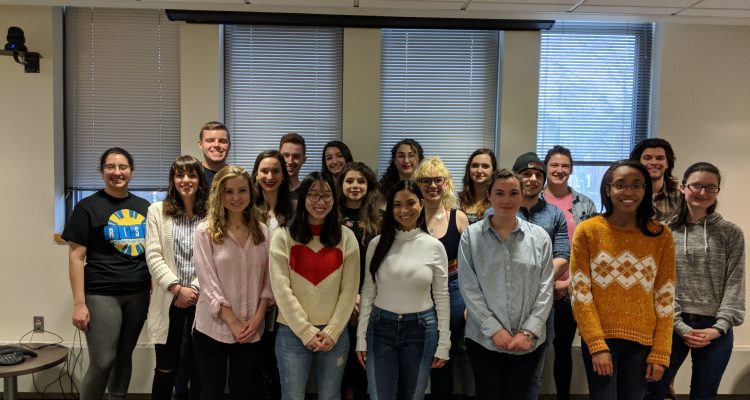By Katherine Sypher
“It’s amazing to see how talented people really are, and I think it’s really brave, too. In some way they are getting out of their comfort zone, they’re taking something that they perhaps wrote on a piece of paper and they’re actually publishing it. It’s great,” said Esther Santiago, a member of the Long River Review.
The Long River Review is UConn’s student-run literary and art magazine.
Every spring, students enrolled in the english course “Literary Magazine Editing” build the year’s issue of Long River Review from scratch.
Students in the class split into panels. There’s one for fiction and drama, one for nonfiction and multimedia, and one for poetry and translations.
Esther Santiago is a fiction panelist.
“What I do mostly with my other staff is we read submissions and we evaluate and we discuss if they would be a good fit for the journal,” Santiago said.
Each panel reads works that have been submitted by UConn students, faculty, and members of the community.
The Long River Review hosts two contests: the Aetna Creative Nonfiction Awards and the Wallace Stevens Poetry Prize.
The Long River Review also accepts submissions for the literary magazine that is published each spring.
Once all the submissions have been read, each panel votes on their favorites. Then, the selected pieces are prepared for publication.
“We like to hear voices that aren’t ordinarily heard- that’s part of our mission statement. We like to hear something unique. We want all student work that is submitted to be in their unique voice — whatever honors that I feel like is great work,” Kelly Rafferty said.
Kelly Rafferty is a poetry panelist.
“So basically, I work with the group of all the other poetry panelists and we pick selections for the magazine. Right now, we’ve just been reading through all the contest submissions. We’ve also been reading through all the general submissions, and we’ve been selecting ones that we feel like would be a good fit for the magazine,” Rafferty said.
How exactly does the class go about creating a literary magazine from scratch?
“Ok, so that’s the fun part,” said Ryan Amato, marketing coordinator for the Long River Review.
Ryan Amato is on the fiction panel.
“So how we did it was, when we got our contest submissions and the general submissions, we went through all of them. We all spent our time reading them and then we all put in our own vote on which ones we liked, which ones we didn’t. And then the ones that were highest, we would come back and we would talk about, revisit. And then eventually we would just keep whittling it down until it got to our favorites,” Amato said.
“We all worked together in deciding the overall theme of the magazine and what direction we’d like to be going in, but each of the panels work individually towards the latter half of class. Generally, because this has been the time when submissions are being read, we would go for the last 20 to 15 last minutes of class in our panel, and we would meet. And we would have already read all the submissions the night before. We would go over and rate them and see which ones we felt like would be a good fit,” Rafferty said.
“We look mostly for stories that have a voice; a voice that is unique, a voice that, you know, [is] something new, not something very cliche,” Santiago said.
For the students working on Long River Review, reading the submissions is the most rewarding part.
“Reading these stories and these pieces that are really- they’re not student-based either, but they’re pretty much from anywhere, that we’ll take from anywhere- so it was really, really cool getting all these submissions and just hearing all these different voices. We’re almost at the point where these pieces are kind of in conversation with one another,” Amato said.
“It’s a lot of work. I guess one of my favorite parts is reading all the submissions, because you see how so many people out there have so much great talent. And, despite even if they’re not english majors or if they are, it’s just like, ‘Wow, people thought of this’. Like, ‘wow’. It’s just, so amazing,” Santiago said.
The Long River Review is a class, but it’s not like most classes on campus.
“It’s a nice of breath of fresh air from the regular classes that I’m used to,” Amato said.
“I’ve never- like when I say to people, ‘Oh, I’m in this really cool class’- like a dork- they’re like, ‘Oh, what’s that’? They don’t really know. I don’t think most people even know that literary magazines in college are even a thing, irregardless [that] ours exists,” Rafferty said.
So, why should you join the Long River Review next spring? Current members have a lot of reasons.
“I think that everybody benefits from literature and art. I don’t think that there’s a single person out there who has never listened to music, or hasn’t ever seen a piece of art that really moved them, or hasn’t read a book where they cried. I think that literature and art are probably one of the most important cultural aspects of, not only university but of all people, to preserve. And I think that having something on campus that honors that and makes that accessible to everybody is so important,” Rafferty said.
The class also offers students interested in publishing hands-on experience.
“It really helped me figure out if this is something that I want to do. That’s why I encourage a lot of people, if you’re considering going into something like this, it’s a perfect opportunity to really get the experience and figure out if you really want to do it,” Amato said.
Darcie Dennigan is the Long River Review’s faculty advisor.
The Long River Review will be available in April, online and in print.


